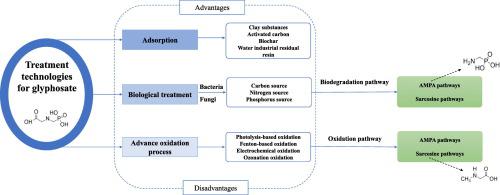Science of the Total Environment ( IF 8.2 ) Pub Date : 2020-06-28 , DOI: 10.1016/j.scitotenv.2020.140559 Dan Feng 1 , Audrey Soric 1 , Olivier Boutin 1

|
Glyphosate is one of the most widely used post-emergence broad-spectrum herbicides in the world. This molecule has been frequently detected in aqueous environment and can cause adverse effects to plants, animals, microorganisms, and humans. This review offers a comparative assessment of current treatment methods (physical, biological, and advanced oxidation process) for glyphosate wastewaters, considering their advantages and drawbacks. As for other molecules, adsorption does not destroy glyphosate. It can be used before other processes, if glyphosate concentrations are very high, or after, to decrease the final concentration of glyphosate and its by-products. Most of biological and oxidation processes can destroy glyphosate molecules, leading to by-products (the main ones being AMAP and sarcosine) that can be or not affected by these processes. This point is of major importance to control process efficiency. That is the reason why a specific focus on glyphosate degradation pathways by biological treatment or different advanced oxidation processes is proposed. However, one process is usually not efficient enough to reach the required standards. Therefore, the combination of processes (for instance biological and oxidation ones) seems to be high-performance technologies for the treatment of glyphosate-containing wastewater, due to their potential to overcome some drawbacks of each individual process. Finally, this review provides indications for future work for different treatment processes to increase their performances and gives some insights into the treatment of glyphosate or other organic contaminants in wastewater.
中文翻译:

草甘膦的处理技术和降解途径:关键评论。
草甘膦是世界上使用最广泛的芽后广谱除草剂之一。该分子经常在水环境中被检测到,并且可能对植物,动物,微生物和人类造成不利影响。这篇综述提供了对草甘膦废水当前处理方法(物理,生物和高级氧化工艺)的比较评估,并考虑了它们的优缺点。至于其他分子,吸附不会破坏草甘膦。如果草甘膦的浓度很高,可以在其他工艺之前使用,也可以在降低草甘膦及其副产物的最终浓度之后使用。大多数生物和氧化过程都会破坏草甘膦分子,导致副产物(主要是AMAP和肌氨酸)受到或不受这些过程的影响。这一点对于控制过程效率至关重要。这就是为什么提出特别关注通过生物处理或不同的高级氧化过程降解草甘膦的途径。但是,一个过程通常效率不足以达到要求的标准。因此,工艺的组合(例如生物工艺和氧化工艺)似乎是用于处理含草甘膦废水的高性能技术,因为它们具有克服每个工艺中某些缺点的潜力。最后,这篇综述为今后不同处理方法的工作提供了指示,以提高其性能,并为废水中草甘膦或其他有机污染物的处理提供了一些见识。这就是为什么提出特别关注通过生物处理或不同的高级氧化过程降解草甘膦的途径。但是,一个过程通常效率不足以达到要求的标准。因此,工艺的组合(例如生物工艺和氧化工艺)似乎是用于处理含草甘膦废水的高性能技术,因为它们具有克服每个工艺中某些缺点的潜力。最后,这篇综述为今后不同处理方法的工作提供了指示,以提高其性能,并为废水中草甘膦或其他有机污染物的处理提供了一些见识。这就是为什么提出特别关注通过生物处理或不同的高级氧化过程降解草甘膦的途径。但是,一个过程通常效率不足以达到要求的标准。因此,工艺的组合(例如生物工艺和氧化工艺)似乎是用于处理含草甘膦废水的高性能技术,因为它们具有克服每个工艺中某些缺点的潜力。最后,这篇综述为今后不同处理方法的工作提供了指示,以提高其性能,并为废水中草甘膦或其他有机污染物的处理提供了一些见识。









































 京公网安备 11010802027423号
京公网安备 11010802027423号